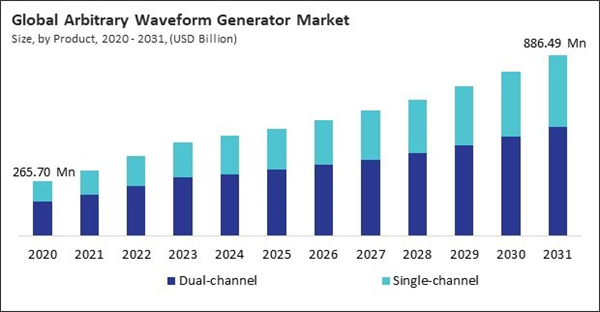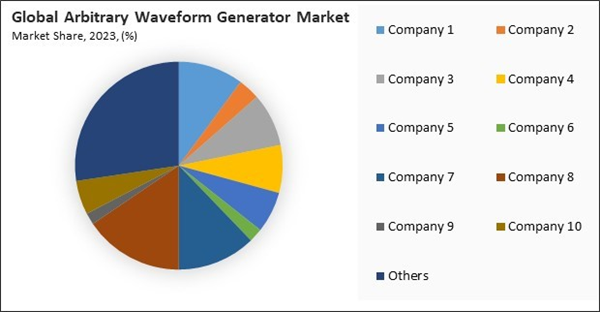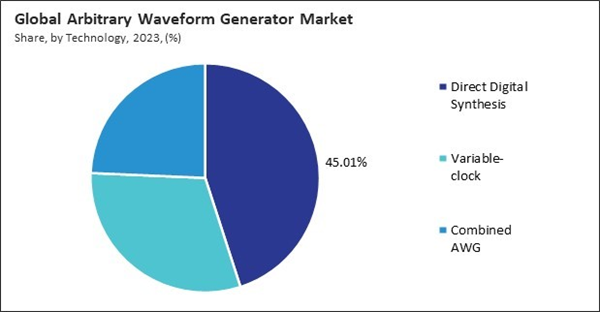The Global Arbitrary Waveform Generator Market size is expected to reach $886.49 Million by 2031, rising at a market growth of 10.5% CAGR during the forecast period.
Arbitrary waveform generators play a crucial role in developing and testing communication protocols, wireless networks, and RF applications. With the rapid expansion of 5G technology and the growing need for high-speed data transmission, telecom companies are heavily investing in precise signal generation tools to enhance network performance and reliability. Additionally, ongoing research in next-generation communication technologies has further fuelled the adoption of arbitrary waveform generators in the telecommunications sector. Thus, the telecommunications segment witnessed 23% revenue share in the market in 2023. This growth is driven by the increasing demand for advanced signal testing and simulation solutions in the telecom industry.
The evolution of telecommunication technologies, particularly with the deployment of 5G and upcoming 6G networks, drives the need for high-precision signal testing and validation tools. Arbitrary Waveform Generators (AWGs) are essential in developing, testing, and troubleshooting advanced communication protocols, ensuring that wireless and wired transmission systems operate efficiently. Thus, as telecom operators push for improved network efficiency and reduced latency, the adoption of AWGs will continue to rise, further fuelling market growth.
Additionally, high-speed data acquisition is critical in industries such as aerospace, defense, medical diagnostics, and scientific research, where accurate signal measurement and processing are necessary. AWGs enable engineers and researchers to generate precise, high-frequency waveforms to simulate real-world signals, improving the accuracy of data acquisition systems. Therefore, growing need for AWG in high-speed data acquisition is driving the growth of the market.
However, AWGs are highly sophisticated instruments that require advanced hardware and software capabilities, resulting in high initial costs. The manufacturing process involves precision engineering, high-speed digital signal processing, and integration with state-of-the-art semiconductor technology. As a result, the cost of acquiring a high-performance AWG can be prohibitive, particularly for small and medium-sized enterprises (SMEs) and research institutions with limited budgets. Hence, high initial cost and maintenance expenses of AWG are hindering the growth of the market.
The leading players in the market are competing with diverse innovative offerings to remain competitive in the market. The above illustration shows the percentage of revenue shared by some of the leading companies in the market. The leading players of the market are adopting various strategies in order to cater demand coming from the different industries. The key developmental strategies in the market are Acquisitions, and Partnerships & Collaborations.
Arbitrary waveform generators play a crucial role in developing and testing communication protocols, wireless networks, and RF applications. With the rapid expansion of 5G technology and the growing need for high-speed data transmission, telecom companies are heavily investing in precise signal generation tools to enhance network performance and reliability. Additionally, ongoing research in next-generation communication technologies has further fuelled the adoption of arbitrary waveform generators in the telecommunications sector. Thus, the telecommunications segment witnessed 23% revenue share in the market in 2023. This growth is driven by the increasing demand for advanced signal testing and simulation solutions in the telecom industry.
The evolution of telecommunication technologies, particularly with the deployment of 5G and upcoming 6G networks, drives the need for high-precision signal testing and validation tools. Arbitrary Waveform Generators (AWGs) are essential in developing, testing, and troubleshooting advanced communication protocols, ensuring that wireless and wired transmission systems operate efficiently. Thus, as telecom operators push for improved network efficiency and reduced latency, the adoption of AWGs will continue to rise, further fuelling market growth.
Additionally, high-speed data acquisition is critical in industries such as aerospace, defense, medical diagnostics, and scientific research, where accurate signal measurement and processing are necessary. AWGs enable engineers and researchers to generate precise, high-frequency waveforms to simulate real-world signals, improving the accuracy of data acquisition systems. Therefore, growing need for AWG in high-speed data acquisition is driving the growth of the market.
However, AWGs are highly sophisticated instruments that require advanced hardware and software capabilities, resulting in high initial costs. The manufacturing process involves precision engineering, high-speed digital signal processing, and integration with state-of-the-art semiconductor technology. As a result, the cost of acquiring a high-performance AWG can be prohibitive, particularly for small and medium-sized enterprises (SMEs) and research institutions with limited budgets. Hence, high initial cost and maintenance expenses of AWG are hindering the growth of the market.
The leading players in the market are competing with diverse innovative offerings to remain competitive in the market. The above illustration shows the percentage of revenue shared by some of the leading companies in the market. The leading players of the market are adopting various strategies in order to cater demand coming from the different industries. The key developmental strategies in the market are Acquisitions, and Partnerships & Collaborations.
Driving and Restraining Factors
Drivers
- Increasing Demand for Advanced Communication Systems in Telecommunication
- Growing Need for Arbitrary Waveform Generators in High-Speed Data Acquisition
- Expansion of Industrial Automation and IoT Applications Worldwide
Restraints
- High Initial Cost and Maintenance Expenses of Arbitrary Waveform Generators
- Complexity in Operation and Requirement for Skilled Workforce
Opportunities
- Rising Demand for AWG in 5G and Next-Gen Wireless Communication Systems
- Supportive Government Initiatives and Funding for Scientific and Technological Research
Challenges
- Rapid Technological Advancements Leading to Frequent Product Obsolescence
- Compatibility Issues with Existing Test and Measurement Ecosystems
Product Outlook
Based on product, the market is characterized into single-channel and dual-channel. The single-channel segment garnered 38% revenue share in the market in 2023. This growth is primarily driven by its widespread adoption in applications requiring cost-effective and efficient signal generation. Single-channel arbitrary waveform generators are widely used in research laboratories, telecommunications, and electronics testing, where precise waveform generation is essential.Technology Outlook
On the basis of technology, the market is classified into direct digital synthesis, variable clock, and combined AWG. The direct digital synthesis segment acquired 45% revenue share in the arbitrary waveform generator market in 2023. The dominance of this segment is attributed to its high-frequency stability, fast switching speed, and precise waveform generation capabilities. DDS-based arbitrary waveform generators are widely used in applications requiring high-resolution signal processing, such as telecommunications, aerospace, and research laboratories.Application Outlook
By application, the market is divided into telecommunications, education, healthcare, electronics, industrial, and others. The education segment held 12% revenue share in the market in 2023. Universities, research institutions, and technical training centers increasingly incorporate waveform generation technology into their curricula to enhance practical learning experiences. Arbitrary waveform generators are used in academic laboratories for teaching students about signal processing, circuit analysis, and communication systems.Regional Outlook
Region-wise, the market is analyzed across North America, Europe, Asia Pacific, and LAMEA. The Asia Pacific segment witnessed 26% revenue share in the market in 2023. The region’s growth is fuelled by the expanding electronics and semiconductor industries, particularly in China, Japan, and South Korea. The rising adoption of IoT devices, consumer electronics, and industrial automation has increased the need for high precision testing equipment, including arbitrary waveform generators.List of Key Companies Profiled
- Rohde & Schwarz GmbH & Co. KG
- Advantest Corporation
- B&K Precision Corporation
- Teledyne Technologies Incorporated
- Anritsu Corporation
- Focus Microwaves, Inc.
- Agilent Technologies, Inc.
- Keysight Technologies, Inc.
- Chroma ATE, Inc.
- Tabor Electronics
Market Report Segmentation
By Product
- Dual-channel
- Single-channel
By Technology
- Direct Digital Synthesis
- Variable-clock
- Combined AWG
By Application
- Telecommunications
- Electronics
- Healthcare
- Education
- Industrial
- Other Application
By Geography
- North America
- US
- Canada
- Mexico
- Rest of North America
- Europe
- Germany
- UK
- France
- Russia
- Spain
- Italy
- Rest of Europe
- Asia Pacific
- China
- Japan
- India
- South Korea
- Singapore
- Malaysia
- Rest of Asia Pacific
- LAMEA
- Brazil
- Argentina
- UAE
- Saudi Arabia
- South Africa
- Nigeria
- Rest of LAMEA
Table of Contents
Chapter 1. Market Scope & Methodology
Chapter 2. Market at a Glance
Chapter 3. Market Overview
Chapter 4. Competition Analysis - Global
Chapter 5. Global Arbitrary Waveform Generator Market by Product
Chapter 6. Global Arbitrary Waveform Generator Market by Technology
Chapter 7. Global Arbitrary Waveform Generator Market by Application
Chapter 8. Global Arbitrary Waveform Generator Market by Region
Chapter 9. Company Profiles
Companies Mentioned
- Rohde & Schwarz GmbH & Co. KG
- Advantest Corporation
- B&K Precision Corporation
- Teledyne Technologies Incorporated
- Anritsu Corporation
- Focus Microwaves, Inc.
- Agilent Technologies, Inc.
- Keysight Technologies, Inc.
- Chroma ATE, Inc.
- Tabor Electronics
Methodology

LOADING...











